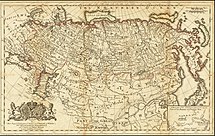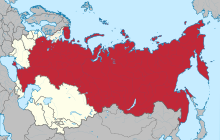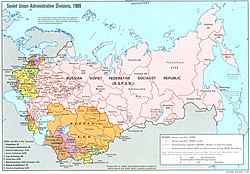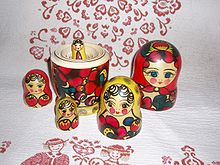Russian Soviet Federative Socialist Republic
Russian Soviet Federative Socialist Republic Российская Советская Федеративная Социалистическая Республика Rossiyskaya Sovetskaya Federativnaya Sotsialisticheskaya Respublika[1] | |||||||||||||||||||||||||||||||||||||||||||||||
|---|---|---|---|---|---|---|---|---|---|---|---|---|---|---|---|---|---|---|---|---|---|---|---|---|---|---|---|---|---|---|---|---|---|---|---|---|---|---|---|---|---|---|---|---|---|---|---|
| 1917–1991 | |||||||||||||||||||||||||||||||||||||||||||||||
| Motto: | |||||||||||||||||||||||||||||||||||||||||||||||
| Head of state | |||||||||||||||||||||||||||||||||||||||||||||||
• 1917 (first) | Lev Kamenevc | ||||||||||||||||||||||||||||||||||||||||||||||
• 1990–1991 (last) | Boris Yeltsind | ||||||||||||||||||||||||||||||||||||||||||||||
Head of government | |||||||||||||||||||||||||||||||||||||||||||||||
• 1917–1924 (first) | Vladimir Lenine | ||||||||||||||||||||||||||||||||||||||||||||||
• 1990–1991 | Ivan Silayevf | ||||||||||||||||||||||||||||||||||||||||||||||
• 1991 (last) | Boris Yeltsing | ||||||||||||||||||||||||||||||||||||||||||||||
| Legislature |
| ||||||||||||||||||||||||||||||||||||||||||||||
• Russian SFSR renamed into the Russian Federation | 25 December 1991 | ||||||||||||||||||||||||||||||||||||||||||||||
| 26 December 1991 | |||||||||||||||||||||||||||||||||||||||||||||||
| 25 December 1993 | |||||||||||||||||||||||||||||||||||||||||||||||
| Area | |||||||||||||||||||||||||||||||||||||||||||||||
| 1956[citation needed] | 17,125,200 km2 (6,612,100 sq mi) | ||||||||||||||||||||||||||||||||||||||||||||||
| Population | |||||||||||||||||||||||||||||||||||||||||||||||
• 1989[citation needed] | 147,386,000 | ||||||||||||||||||||||||||||||||||||||||||||||
| Currency | UTC +2 to +12) | ||||||||||||||||||||||||||||||||||||||||||||||
| Calling code | +7 | ||||||||||||||||||||||||||||||||||||||||||||||
| ISO 3166 code | RU | ||||||||||||||||||||||||||||||||||||||||||||||
| Internet TLD | .su | ||||||||||||||||||||||||||||||||||||||||||||||
| |||||||||||||||||||||||||||||||||||||||||||||||
| |||||||||||||||||||||||||||||||||||||||||||||||
Seven Russian Democratic Federative Republic existed briefly on 19 January 1918, but actual sovereignty was still in the hands of the Soviets even after the Russian Constituent Assembly opened its first and last session in 1918.[8] | |||||||||||||||||||||||||||||||||||||||||||||||
The Russian Soviet Federative Socialist Republic (Russian SFSR or RSFSR;
The economy of Russia became heavily industrialized, accounting for about two-thirds of the electricity produced in the USSR. By 1961, it was the third largest producer of petroleum due to new discoveries in the Volga-Urals region[14] and Siberia, trailing in production to only the United States and Saudi Arabia.[15] In 1974, there were 475 institutes of higher education in the republic providing education in 47 languages to some 23,941,000 students. A network of territorially organized public-health services provided health care.[13] The economy, which had become stagnant since the late 1970s under General Secretary Leonid Brezhnev, began to be liberalized starting in 1985 under Gorbachev's "perestroika" restructuring policies, including the introduction of non-state owned enterprises (e.g. cooperatives).
On 7 November 1917 [O.S. 25 October], as a result of the
The
On 25 December 1991, following the resignation of Gorbachev as
The 1978 constitution of the Russian SFSR was amended several times to reflect the transition to democracy, private property and market economy. The new
Nomenclature
This section needs additional citations for verification. (February 2022) |
Under the
Anti-Bolsheviks soon suggested new names, however. By 1919 they had coined the mocking label Sovdepia (Russian: Совдепия) for the nascent state of the Soviets of Workers' and Peasants' Deputies.[20] Speakers of colloquial English coined the term "Bololand"[21] to refer to the land of the Bolos (a term identified from 1919 onwards with the Bolsheviks).[22]
On 25 January 1918 the third meeting of the
Internationally, the Russian SFSR was recognized as an independent state in 1920 only by its bordering neighbors (
On 30 December 1922,
The RSFSR dominated the Soviet Union to such an extent that for most of the Soviet Union's existence, it was commonly, but incorrectly, referred[
On 25 December 1991, during the collapse of the Soviet Union, which concluded on the next day, the RSFSR's official name was changed to the Russian Federation, which it remains to this day.[27] This name and "Russia" were specified as the official state names on 21 April 1992, in an amendment to the then existing Constitution of 1978, and were retained as such in the subsequent 1993 Constitution of Russia.
Geography
At a total of about 17,125,200 km (6,612,100 sq mi), the Russian SFSR was the largest of the fifteen Soviet republics, with its southerly neighbor, the
The international borders of the RSFSR touched
Roughly 70% of the area in the RSFSR consisted of broad plains, with mountainous tundra regions mainly concentrated in the east of Siberia with Central Asia and East Asia. The area is rich in mineral resources, including petroleum, natural gas, and iron ore.[28]
History
| Eastern Bloc |
|---|
 |
| History of Russia |
|---|
 |
|
|
Early years (1917–1920)
The Soviet government first came to power on 7 November 1917, immediately after the interim Russian Provisional Government headed by Alexander Kerensky, which governed the Russian Republic, was overthrown in the October Revolution, the second of the two Russian Revolutions. The state it governed, which did not have an official name, would be unrecognized by neighboring countries for another five months.
On 18 January 1918, the newly elected
On 25 January 1918, at the third meeting of the
within the former Russian Empire had seceded, reducing the size of the country even more, although some were conquered by the Bolsheviks.1920s



The
The economic impact of the Civil War was devastating. A
On 30 December 1922, the
One of the early ambitious economic plans of the Soviet government was
Paragraph 3 of Chapter 1 of the 1925 Constitution of the RSFSR stated the following:[41]
By the will of the peoples of the Russian Socialist Federative Soviet Republic, who decided on the formation of the Union of Soviet Socialist Republics during the Tenth All-Russian Congress of Soviets, the Russian Socialist Federative Soviet Republic, being a part of the Union of Soviet Socialist Republics, devolves to the Union the powers which according to Article 1 of the Constitution of the Union of Soviet Socialist Republics are included within the scope of responsibilities of the government bodies of the Union of Soviet Socialist Republics.
1930s

Many regions in Russia were affected by the
The final name for the republic during the Soviet era was adopted by the Russian Constitution of 1937, which renamed it the Russian Soviet Federative Socialist Republic (RSFSR).
1940s

Just four months after
In 1943,
On 3 March 1944, on the orders of Stalin, the
On 11 October 1944, the
After reconquering Estonia and Latvia in 1944, the Russian SFSR annexed their easternmost territories around Ivangorod and within the modern Pechorsky and Pytalovsky Districts in 1944–1945.

At the end of World War II Soviet troops of the
On 17 April 1946, the Kaliningrad Oblast – the north-eastern portion of the former Kingdom of Prussia, the founding state of the German Empire (1871–1918) and later the German province of East Prussia including the capital and Baltic seaport city of Königsberg – was annexed by the Soviet Union and made part of the Russian SFSR.
1950s

After the death of Joseph Stalin on 5 March 1953,
The
On 9 January 1957,
1960s–1980s

In 1964, Nikita Khrushchev was removed from his position of power and replaced with
On 12 April 1978, a new Constitution of Russia was adopted.[42]
Early 1990s
On 29 May 1990, at his third attempt, Boris Yeltsin was

On 17 March 1991, an all-Russian referendum created the post of President of the RSFSR and on 12 June, Boris Yeltsin was elected president by popular vote.
During the unsuccessful
On 8 December 1991, at
On 24 December, Yeltsin informed the
On 21 April 1992, the Congress of People's Deputies of Russia approved the renaming of the RSFSR into the Russian Federation, by making appropriate amendments to the Constitution, which entered into force since publication on 16 May 1992.[54]
Government
The Government was known officially as the
Autonomous republics within the Russian SFSR
- Kara-Kalpakautonomous oblasts. The latter was part of the Kirgiz, then the Kazak ASSR until 1930 when it was directly subordinated to Moscow.
- Republic of Bashkortostan.
- Republic of Tatarstanand on 18 October 1991 declared its independence. The Russian constitutional court overturned the declaration on 13 March 1992. In February 1994, a separate agreement was reached with Moscow on the status of Tatarstan as an associate state in Russia with confederate status.
- Syr Darya and Samarkandoblasts. On 19 April 1925, it was renamed Kazak ASSR. (see below)
- Mountain ASSR was formed on 20 January 1921 after the Bolshevik Red Army evicted the short-lived Mountainous Republic of the Northern Caucasus. Initially composed of several national districts, one-by-one these left the republic until 7 November 1924 when the remains of the republic was partitioned into the Ingush Autonomous Oblast, the North Ossetian Autonomous Oblast and the Sunzha Cossack District (all subordinates to the North Caucasus Krai).
- Dagestan ASSR was formed on 20 January 1921 from the former Dagestan Oblast. On 17 September 1991, it declared sovereignty as the Dagestan SSR.
- Russian military intervention and a disputed referendum, Crimea was annexed by Russiain March 2014, a move largely considered illegal by the international community.
- Yakut ASSR was formed on 16 February 1922 upon the elevation of the Yakut Autonomous Oblast into an ASSR. On 27 September 1990, it declared sovereignty as the Yakut-Sakha Soviet Socialist Republic. From 21 December 1991, it has been known as the Republic of Sakha (Yakutia).
- Republic of Buryatia.
- Karelo-Finnish SSR. On 16 July 1956, it was downgraded in status to that of an ASSR and re-subordinated to RSFSR. It declared sovereignty on 13 October 1991 as the Republic of Karelia.
- Volga German ASSR was formed on 19 December 1924 upon elevation of the Volga German Autonomous Oblast into an ASSR. On 28 August 1941, upon the deportation of Volga Germans to Central Asia, the ASSR was disbanded. The territory was partitioned between the Saratov and Stalingrad Oblasts.
- Republic of Kazakhstan.
- Chuvash ASSR was formed on 21 April 1925 upon the elevation of the Chuvash Autonomous Oblast into an ASSR. It declared sovereignty on 26 October 1990 as the Chuvash SSR.
- Kirghiz Autonomous Oblast. Upon the ratification of the new Soviet constitution, the ASSR was elevated into a full Union Republic on 3 December 1936. On 12 December 1990, it declared sovereignty as the Republic of Kyrgyzstanand on 31 August 1991 its independence.
- Uzbek SSR. In 1964, it was renamed the Karakalpak ASSR. It declared sovereignty on 14 December 1990.
- Republic of Mordovia.
- Udmurt Republic.
- Kalmyk ASSR was formed on 20 October 1935 upon the elevation of Kalmyk Autonomous Oblast into an ASSR. On 27 December 1943, upon the deportation of the Kalmyks, the ASSR was disbanded and split between the newly established Astrakhan Oblast and parts adjoined to Rostov Oblast, Krasnodar Krai and Stavropol Krai. On 9 January 1957, Kalmyk Autonomous Oblast was re-established in its present borders, first as a part of Stavropol Krai and from 19 July 1958 as a part of the Kalmyk ASSR. On 18 October 1990, it declared sovereignty as the Kalmyk SSR.
- Georgian SSR. Upon the return of the Balkars, the KBASSR is re-instated on 9 January 1957. On 31 January 1991, the republic declared sovereignty as the Kabardino-Balkar SSR and from 10 March 1992 as the Kabardino-BalkarianRepublic.
- North Caucasus Kray and its constituent North Ossetian Autonomous Oblastwas raised into an ASSR. Declared sovereignty on 26 December 1990 as the North Ossetian SSR.
- Chechen Republicgovernment was re-established on 15 October 1999.
- Republic of Komi.
- Mari ASSR was formed on 5 December 1936 upon the elevation of the Mari Autonomous Oblast into an ASSR. Declared Sovereignty on 22 December 1990 as the Mari Soviet Socialist Republic (Mari El).
- Tuva Autonomous Oblast was elevated[by whom?] into an ASSR. On 12 December 1990, it declared sovereignty as the Soviet Republic of Tyva.
- Gorno-Altai ASSR was formed on 25 October 1990 when Gorno-Altai Autonomous Oblast declared sovereignty. Since 3 July 1991, it has been known as the Gorno-Altai SSR.
- Karachayevo-Cherkessian ASSR was formed on 17 November 1990 when Karachay-Cherkess Autonomous Oblast was elevated into an ASSR and instead of Stavropol Krai subordinated directly to the RSFSR. It declared sovereignty on 3 July 1991 as the Karachay-Cherkess SSR.
Economy
In the first years of the existence of the RSFSR, the doctrine of war communism became the starting point of the state's economic activity. In March 1921, at the X Congress of the RCP (B), the tasks of the policy of "war communism" were recognized by the country's leadership as fulfilled, and a new economic policy was introduced at Lenin's suggestion.
After the formation of the Soviet Union, the economy of the RSFSR became an integral part of the economy of the USSR. The economic program of the RSFSR (NEP) was continued in all union republics. The Gosplan (State General Planning Commission) of the RSFSR, which replaced GOELRO, was reorganized into the Gosplan of the USSR. His early task was to develop a unified national economic plan based on the electrification plan and to oversee the overall implementation of this plan.
Unlike the previous Russian constitutions, the 1978 Constitution devoted an entire chapter (Chapter II) to the description of the economic system of the RSFSR, which defined the types of property and indicated the goals of the economic tasks of the state.[55]
As noted by Corresponding Member RAS RAS V. I. Suslov, who took part in large-scale studies of the relationship between the economies of the republics of the USSR and the RSFSR in the late Soviet era: "The degree of inequality of economic exchange was very high, and Russia was always the losing side. The product created by Russia largely supported the consumption of other union republics".[56]
Culture
National holidays and symbols
The public holidays for the Russian SFSR included

During its 76-year existence, the Russian SFSR anthem was the same as the Soviet anthem (unlike other republics):
The
Flag history
The flag of the Russian SFSR changed numerous times, with the original being a field of red with the Russian name of the republic written on the flag's centre in white. This flag had always been intended to be temporary, as it was changed less than a year after its adoption. The second flag had the letters РСФСР (RSFSR) written in yellow within the
Bibliographies
- Bibliography of the Russian Revolution and Civil War
- Bibliography of Stalinism and the Soviet Union
- Bibliography of the post-Stalinist Soviet Union
Notes
- Russian Federationuntil 1993.
References
- ^ Historical names:
- 1918: Russian Soviet Republic (Российская Советская Республика; Rossiyskaya Sovetskaya Respublika)
- 1918–1936: Russian Socialist Federative Soviet Republic (Российская Социалистическая Федеративная Советская Республика; Rossiyskaya Sotsialisticheskaya Federativnaya Sovetskaya Respublika)
- 1936–1991: Russian Soviet Federative Socialist Republic (Российская Советская Федеративная Социалистическая Республика; Rossiyskaya Sovetskaya Federativnaya Sotsialisticheskaya Respublika)
- ^ Arthur Ransome (16 March 1918). "Lenine's Migration A Queer Scene". Archived 16 September 2018 at the Wayback Machine. The New York Times.
- Left SRs, and the Menshevik-Internationalists formed a Socialist coalition government that lasted until March 1918 (Historical Dictionary of the Russian Revolution. J. Davis. p. 58); the Mensheviks were allowed to legally hold a congress in 1920 and continued to be elected to the Congress of Soviets until being outlawed in 1921 (Lenin's Legacy. R. Wesson, 1978).
- ^ Historical Dictionary of Socialism. James C. Docherty, Peter Lamb. Page 85. "The Soviet Union was a one-party Marxist-Leninist state."
- ^ "Law of the USSR of 14 March 1990 N 1360-I 'On the establishment of the office of the President of the USSR and the making of changes and additions to the Constitution (Basic Law) of the USSR'". Garant.ru. Archived from the original on 13 August 2011. Retrieved 12 July 2010.
- ^ article 114 of the 1937 Constitution, article 171 of the 1978 Constitution
- ^ ISBN 978-0-521-45770-5.
- ISBN 0-19-512179-1.
- ^ a b c Конституции РСФСР 1918 г. Archived 2 July 2018 at the Wayback Machine (in Russian). Hist.msu.ru. Retrieved on 22 June 2011.
- ^ ISBN 9781443855211.
- ^ Declaration of Rights of the laboring and exploited people (original VTsIK variant Archived 7 August 2011 at the Wayback Machine, III Congress revision), article I.
- Transcaucasian Federation" in the south until 1936). See for example, the log of the meeting of the Supreme Soviet of the USSR on 19 February 1954 Archived 12 September 2012 at archive.today. The Russian SFSR officially renamed into the Russian Federation on Christmas Day, 25 December 1991.
- ^ a b c d The Free Dictionary Russian Soviet Federated Socialist Republic Archived 13 August 2011 at the Wayback Machine. Encyclopedia2.thefreedictionary.com. Retrieved on 22 June 2011.
- ^ Peterson, James A.; Clarke, James W. "Petroleum Geology and Resources of the Volga-Ural Province, U.S.S.R." (PDF). Pubs.USGS.gov. 1983, U.S. Department of the Interior – U.S. Geological Survey. Archived (PDF) from the original on 2 April 2015. Retrieved 11 March 2015.
- ISBN 0898757258. Archivedfrom the original on 2 April 2015. Retrieved 11 March 2015.
- ^ Article 76
- ^ Article 72
- ^ The names Russian Federation and Russia have been equal since 25 December 1993
- ^ a b Letter to the Secretary-General of the United Nations from the President of the Russian Federation
- ISBN 9781933648156. Retrieved 25 January 2014.
The Bolsheviks' enemies gave the name 'Sovdepia' to the area under the authority of the Soviets of Workers' and Peasants' Deputies. The comic-opera term was intended to mock [...].
- ^
Note especially:
Patenaude, Bertrand M. (2002). The Big Show in Bololand: The American Relief Expedition to Soviet Russia in the Famine of 1921. Stanford, California: Stanford University Press. p. 687. ISBN 0804744939. Retrieved 16 April 2024.
[Turrou] had succeeded in gaining the confidence of the Soviet leaders and had thus been able to learn the inside story about Bolo affairs.
- ^ "Bolo". Oxford English Dictionary (Online ed.). Oxford University Press. (Subscription or participating institution membership required.) - "Misused for: a Bolshevik. Also collective singular = the Bolshevists. Also attributive."
- ^ ISBN 9780674018013.
- ^ a b Soviet Russia information Archived 26 August 2010 at the Wayback Machine. Russians.net (23 August 1943). Retrieved on 22 June 2011.
- ^ Carr, EH The Bolshevik Revolution 1917–23, vol. 3 Penguin Books, London, 4th reprint (1983), pp. 257–258. The draft treaty was published for propaganda purposes in the 1921 British document Intercourse between Bolshevism and Sinn Féin (Cmd 1326).
- ISBN 978-0-393-08192-3.
- ^ Chronicle of Events Archived 27 July 2011 at the Wayback Machine. Marxistsfr.org. Retrieved on 22 June 2011.
- ^ "Russia the Great: Mineral resources". Russian Information Network. Archived from the original on 19 January 2011. Retrieved 22 November 2010.
- ^ Ikov, Marat Sal. "Round Table the Influence Of National Relations on the Development of the Federative State Structure and on the Social and Political Realities of the Russian Federation". Prof.Msu.RU. Retrieved 9 February 2021.
However, historically, the first proclamation of the federation was made somewhat earlier – by the Constituent Assembly of Russia. In his short resolution of 6 (18) January 1918, the following was enshrined: 'In the name of the peoples, the state of the Russian constituent, the All-Russian Constituent Assembly decides: the Russian state is proclaimed by the Russian Democratic Federal Republic, uniting peoples and regions in an indissoluble union, within the limits established by the federal constitution. Of course, the above resolution, which did not thoroughly regulate the entire system of federal relations, was not considered by the authorities as having legal force, especially after the dissolution of the Constituent Assembly.'
- ^ Deutscher, Isaac (1954). The Prophet Armed Trotsky 1879-1921 (1954). Oxford University Press. pp. 330–336.
- ^ Abramovitch, Raphael R. (1985). The Soviet Revolution, 1917-1939. International Universities Press. p. 130.
- ISBN 978-0-7864-5647-5.
- ^ Ugri͡umov, Aleksandr Leontʹevich (1976). Lenin's Plan for Building Socialism in the USSR, 1917–1925. Novosti Press Agency Publishing House. p. 48.
- ISBN 978-1-349-05591-3.
- ISBN 9780674076082. Archivedfrom the original on 27 June 2018. Retrieved 5 May 2019.
- ^ Lih, Lars T. (1990). "8 Leaving Troubled Times". Bread and Authority in Russia, 1914-1921. UC Press E-Books Collection, 1982-2004. Archived from the original on 27 October 2021. Retrieved 27 October 2021.
- ^ "Source List and Detailed Death Tolls for the Primary Megadeaths of the Twentieth Century". Necrometrics. February 2011. Retrieved 12 December 2017.
- ISBN 0-333-66294-6.
- ^ Развитие электроэнергетики в СССР (к 80летию плана ГОЭЛРО) (in Russian). Archived from the original on 22 October 2018. Retrieved 8 April 2013.
- ^ Никитин, Олег (February 2010). Плюс электрификация. Forbes (in Russian).
- ^ Constitution (Basic Law) of the Russian Socialist Federative Soviet Republic (approved by Twelfth All-Russian Congress of Soviets on 11 May 1925).
- ^ The Constitution (Basic Law) of the Russian Soviet Federative Socialist Republic.
- ^ Decree of the President of the Russian SFSR of 23 August 1991 No. 79
- ^ Decree of the President of the Russian SFSR 06.11. 1991 N169 "On activity of the CPSU and the Communist Party of the Russian SFSR"
- ^ Francis X. Clines, "Gorbachev is Ready to Resign as Post-Soviet Plan Advances", The New York Times, 13 December 1991.
- ^ V.Pribylovsky, Gr.Tochkin . Kto i kak uprazdnil SSSR
- ^ Из СССР В СНГ: подчиняясь реальности
- ^ Бабурин С. Н. На гибель Советского Союза
- ^ Воронин Ю. М. Беловежское предательство Archived 12 August 2020 at the Wayback Machine
- ^ Исаков В. Б. Расчленёнка. Кто и как развалил Советский Союз: Хроника. Документы. — М., Закон и право. 1998. — C. 58. — 209 с.
- ^ Станкевич З. А. История крушения СССР: политико-правовые аспекты. — М., 2001. — C. 299—300
- ^ Лукашевич Д. А. Юридический механизм разрушения СССР. — М, 2016. — С. 254—255. — 448 с.
- ^ Supreme Soviet of the Russian SFSR approved the Law of the RSFSR #2094-I of 25 December 1991 "On renaming of the Russian Soviet Federative Socialist Republic" Archived 20 May 2009 at the Wayback Machine // Congress of People's Deputies of the Russian SFSR and Supreme Soviet of the Russian SFSR Daily. – 1992. – No. 2. – Article 62
- ^ Закон Российской Федерации от 21 апреля 1992 года № 2708-I «Об изменениях и дополнениях Конституции (Основного Закона) Российской Советской Федеративной Социалистической Республики» // «Российская газета», 16 мая 1992 года, № 111 (447), с. 3–5
- ^ "Конституция РСФСР в редакции от 12 апреля 1978 г." constitution.garant.ru. Retrieved 17 November 2021.
- ^ "Наука в Сибири". www.nsc.ru. Archived from the original on 9 March 2014. Retrieved 17 November 2021.
- ^ Resolution of the Supreme Soviet of the Russian SFSR from 22 August 1991 "On the national flag of the Russian SFSR" Archived 10 June 2017 at the Wayback Machine
- ^ Law "On Amendments and Additions to the Constitution (Basic Law) of the Russian SFSR" Archived 16 July 2011 at the Wayback Machine from 1 November 1991










![1991[57][58][a]](http://upload.wikimedia.org/wikipedia/commons/thumb/3/32/Flag_of_Russia_%281991%E2%80%931993%29.svg/180px-Flag_of_Russia_%281991%E2%80%931993%29.svg.png)